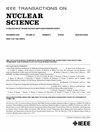Assuring Radiation Tolerance of a Langmuir Probe Instrument for Low-Cost Interplanetary Missions
IF 1.9
3区 工程技术
Q3 ENGINEERING, ELECTRICAL & ELECTRONIC
引用次数: 0
Abstract
With recent advancements in small-satellite technology and the onset of industry-wide budget constraints, the field of planetary space exploration has begun directing efforts toward the production of low-cost missions that are capable of achieving big-budget science objectives. For any interplanetary mission, radiation tolerance assurance is necessary to maximize the survivability of an instrument and characterize its measurement performance throughout the mission flight profile. In this work, the process of ensuring radiation tolerance is demonstrated for a suite of Langmuir probe instruments that will fly on NASA’s upcoming dual small-satellite mission to Mars, the Escape and Plasma Acceleration and Dynamics Explorers (ESCAPADE). A case study is presented in radiation environment modeling, component selection, single-event effect (SEE) considerations, total ionizing dose (TID) testing practices, data processing, and risk assessment to demonstrate instrument performance assurance techniques that could apply to other similar low-cost interplanetary missions. It is shown that the ESCAPADE Langmuir probe (ELP) instrument design satisfies accuracy requirements after radiation testing up to 25 krad(Si). In addition, the viability of commercial components for long-duration space missions is discussed, and the results are presented for a low-cost analog-to-digital converter (ADC).确保用于低成本星际飞行任务的朗缪尔探针仪器的辐射耐受性
随着最近小型卫星技术的进步和全行业预算限制的出现,行星空间探索领域已开始将工作重点放在制作能够实现大预算科学目标的低成本飞行任务上。对于任何行星际飞行任务来说,辐射容限保证都是必要的,这样才能最大限度地提高仪器的生存能力,并在整个任务飞行过程中确定其测量性能的特征。在这项工作中,将为一套朗缪尔探测仪器演示确保辐射耐受性的过程,这套仪器将搭载在美国宇航局即将执行的火星双小卫星任务--逃逸和等离子加速与动力学探索者(ESCAPADE)上。案例研究涉及辐射环境建模、组件选择、单次事件效应(SEE)考虑、总电离剂量(TID)测试实践、数据处理和风险评估,以展示可应用于其他类似低成本星际飞行任务的仪器性能保证技术。结果表明,ESCAPADE 朗缪尔探测器(ELP)的仪器设计在经过高达 25 krad(Si)的辐射测试后满足了精度要求。此外,还讨论了商业组件在长时间空间飞行任务中的可行性,并介绍了低成本模数转换器(ADC)的结果。
本文章由计算机程序翻译,如有差异,请以英文原文为准。
求助全文
约1分钟内获得全文
求助全文
来源期刊

IEEE Transactions on Nuclear Science
工程技术-工程:电子与电气
CiteScore
3.70
自引率
27.80%
发文量
314
审稿时长
6.2 months
期刊介绍:
The IEEE Transactions on Nuclear Science is a publication of the IEEE Nuclear and Plasma Sciences Society. It is viewed as the primary source of technical information in many of the areas it covers. As judged by JCR impact factor, TNS consistently ranks in the top five journals in the category of Nuclear Science & Technology. It has one of the higher immediacy indices, indicating that the information it publishes is viewed as timely, and has a relatively long citation half-life, indicating that the published information also is viewed as valuable for a number of years.
The IEEE Transactions on Nuclear Science is published bimonthly. Its scope includes all aspects of the theory and application of nuclear science and engineering. It focuses on instrumentation for the detection and measurement of ionizing radiation; particle accelerators and their controls; nuclear medicine and its application; effects of radiation on materials, components, and systems; reactor instrumentation and controls; and measurement of radiation in space.
 求助内容:
求助内容: 应助结果提醒方式:
应助结果提醒方式:


